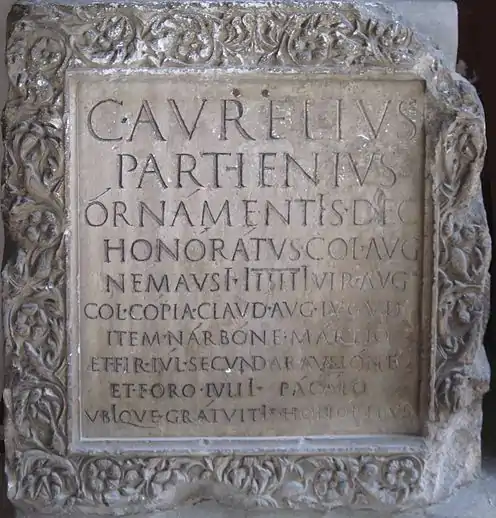Long I
Long i (Latin: i longum or [littera] i longa), written ⟨ꟾ⟩, is a variant of the letter i found in ancient and early medieval forms of Latin script.
In inscriptions dating to the Roman Empire it is used frequently, but inconsistently, to transcribe the long vowel /iː/. In this role it is equivalent to the (also inconsistently-used) apex, which however can appear on any long vowel: ⟨á é í ó v́⟩ /aː eː iː oː uː/. An example would be FꟾLIꟾ, which is generally spelled fīliī today, with macrons rather than apices representing vowel length. On rare occasions an apex could combine with long i to form ⟨ꟾ́⟩.
The long i could also be used to indicate the semivowel [j], e.g. ⟨ꟾVSTVS⟩ or ⟨CVIꟾVS⟩,[1] pronounced /jʊstʊs, kʊjːʊs/. This includes instances of the semivowel /j/ after a consonant, as observed on occasion in Latin poetry, e.g. CLAVDꟾO, representing /klau̯djoː/.
In some forms of New Roman cursive— as well pre-Carolingian scripts of the Early Middle Ages such as Visigothic or Merovingian— it came to also stand for vowels in word-initial position, particularly in the preposition in and its corresponding prefix. For instance ⟨ꟾNponunt ꟾn umeroſ⟩, which would read inpōnunt in umerōs in modern spelling.
 Roman inscription, ca. AD 100, showing long i's contrasting with apices on other vowels. ÓRNÁMENTꟾS in line 3, and VBꟾQVE in the bottom line (besides other words), can be seen containing long i's to represent the vowel /iː/. |
 Roman inscription, ca. AD 45, showing a use of long i for /j/ after a distinct consonant in the top line: CLAVDꟾO. |
 Excerpt from the Lectionary of Luxeuil (ms. Lat. 9427, at the National Library of France), from the late 7th or early 8th century, in the Merovingian script of the a-c (so-called "Luxeuil") type, folio 95v. Three uses of word-initial long i may be observed: incredulis (line 1), impetum ignis (line 7). |
References
- Allen, Sydney (1978). Vox Latina: The Pronunciation of Classical Latin (2nd ed.). Gateshead, England: Athenaeum Press. pp. 37–39. ISBN 0-521-22049-1.
See also
External links
- Davud J. Perry (2006-08-01). "Proposal to Add Additional Ancient Roman Characters to UCS" (PDF). Retrieved 2018-09-30. – Adds U+A7FE LATIN EPIGRAPHIC LETTER I LONGA to Unicode.